I love camping and always look for ways to make my experience better. Doing DIY camping projects lets me make my outdoor space my own. It’s a fun way to be creative and feel like I own the place.
These projects can turn any camping trip into something special. I’ll show you how simple projects can make your camping more comfortable and fun. For more ideas and tips, check out this resource: camping hacks.
Key Takeaways
- DIY camping projects enhance functionality and aesthetics.
- Affordable camping upgrades can improve your overall experience.
- Engaging in these projects fosters creativity and personalization.
- Practical outdoor projects make life easier while camping.
- Customized campsites promote a deeper connection with nature.
Introduction to DIY Camping Projects
I love doing DIY projects for camping because they make my trips special. They let me be creative and make my camping unique. Adding my own touches to my gear or campsite makes it even better.
DIY camping projects are great for spending time with friends and family. We have fun making things like a portable campfire or a custom sign. It’s exciting and makes us feel proud of what we’ve made.
Exploring DIY projects opens up new possibilities for my camping trips. Each thing I make adds to the story of my adventure. It shows off my style and makes planning my trips more fun.
Why DIY Projects are Great for Camping
DIY camping makes outdoor adventures personal. I love making my gear fit my needs, making trips fun and efficient. DIY projects bring a creative spirit to camping, solving common problems in unique ways.
These projects also save money. I can use what I have or find cheap alternatives. This way, I can have a great campsite without spending a lot. It’s about being creative and making the most of what I have.
To wrap it up, DIY projects are more than just fun. They make camping trips memorable and personal. They encourage creativity, adaptability, and save money, making each trip special.
5 DIY Camping Projects to Improve Your Campsite
Going on a nature adventure opens up many exciting possibilities. One great way to make your outdoor time even better is by doing DIY campsite projects. I’ve found five cool camping project ideas that can really make your campsite better. Each project helps solve common camping problems in a fun and useful way.
A portable shower made from a 5-gallon bucket is a great way to stay clean after hiking. External mounts are perfect for storing extra gear, keeping things organized. For nights under the stars, DIY bucket lights provide a clever lighting solution. They light up paths without attracting bugs.
Another smart idea is to make plastic bottle mosquito traps. They help keep mosquitoes away. Also, building a camping kitchen organizer makes cooking easier and neater.
For more tips on these projects, check out a variety of campsite upgrades. These ideas not only make camping more convenient but also add comfort and creativity to your outdoor adventures.
Project 1: Building a Portable Campfire
Building a portable campfire is key for those who love cooking and warmth outdoors. It’s not just convenient. It also makes camping fire safety easier by letting you manage the fire better.
Materials Needed
- Fireproof container (like a metal bucket or a portable fire pit)
- Charcoal or wood (suitable for use in a portable campfire)
- Fire starters (dryer lint, newspaper, or commercial fire starters)
- Grilling grate (for cooking food)
- Water or sand (for extinguishing the fire safely)
Step-by-Step Instructions
- Find a spot that’s safe for fires, like a campsite with fire rings.
- Place your fireproof container on the ground securely.
- Put a layer of charcoal or wood inside, leaving room for air.
- Light the fire starters around the fuel, being careful.
- When the fire is strong, put a grilling grate over it for cooking.
- Keep water or sand ready to safely put out the fire when you’re done.
Project 2: Creating a Personalized Campsite Sign
Adding a personal touch to my campsite makes it special. A customized camping sign is a great way to do this. It shows off my personality and style. Here are some things to think about for this fun project.
Choosing the Right Materials
Choosing the right materials is key for both looks and durability. Here are some good options:
- Wood: It has a rustic look and can last long if treated right.
- Metal: It’s durable and modern, with a shiny finish.
- Plastic: It’s light, weather-resistant, and easy to set up.
Design Tips for Unique Signs
For a sign that stands out, think about design carefully. Here are some tips for a sign that’s both eye-catching and useful:
- Color Contrast: Use bright colors that pop against the background.
- Font Selection: Pick fonts that are clear and bold, easy to read from far away.
- Personal Touch: Add symbols or images that show what I like to make the sign mine.
| Material | Durability | Design Flexibility |
|---|---|---|
| Wood | Moderate | High |
| Metal | High | Moderate |
| Plastic | Low | Moderate |
Project 3: DIY Camping Gear Organizer
Building a DIY camping gear organizer is a smart way to keep your gear tidy. It makes sure you can find what you need quickly. I’ve found that making my own storage adds a personal touch and saves space in my tent or car.
There are many ways to organize your camping gear. You can use mesh bags, plastic bins, or fabric pockets. Using the vertical space is key, especially in small tents. Hanging organizers or shelves are perfect for this.
Here are some materials I suggest for your DIY camping storage project:
- Mesh bags for visibility and breathability
- Plastic containers for waterproof storage
- Strong fabric or canvas for durable pockets
- Hooks and carabiners for securing items
- Velcro straps for easy attachment and detachment
By making your gear organizer fit your needs, camping becomes more fun. No more digging through messy piles. Everything has its place, making your outdoor adventures smoother.
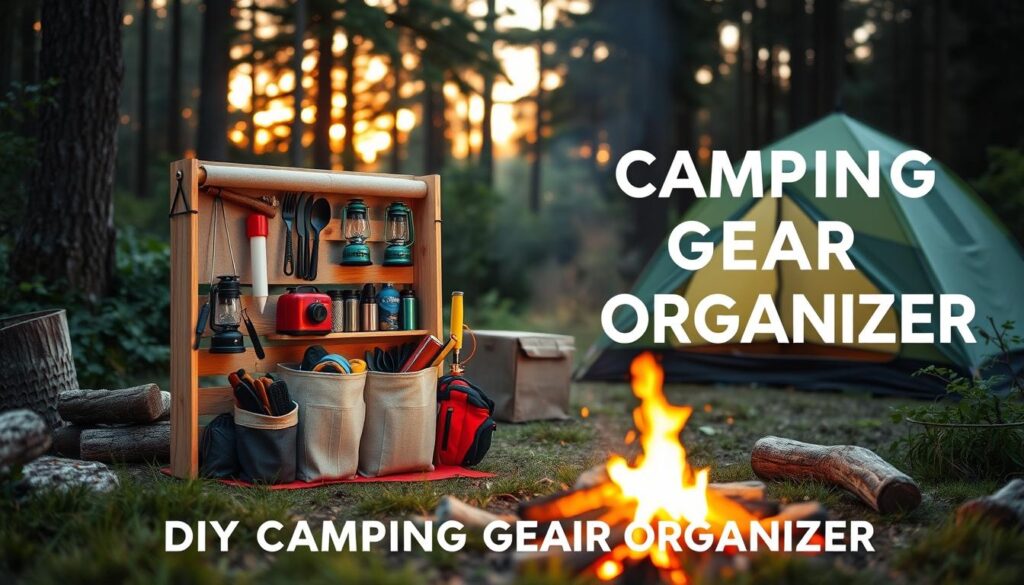
Project 4: Upcycling for Outdoor Decor
Upcycling is more than just a trend; it’s a way to make my camping trips more sustainable. It lets me add a personal touch to my outdoor space. Old materials get a new life as beautiful decor pieces.
This approach boosts my creativity and supports eco-friendly living. It makes my campsite stand out and feel welcoming.
Ideas for Upcycling Materials
There are many ways to upcycle for camping decor. Here are some ideas to get you started:
- Pallet Furniture: Old pallets can become rustic benches or tables. A bit of sanding and staining can make them look great and last longer.
- Tin Can Lanterns: Turn tin cans into lanterns for cozy night gatherings. Add some paint or carvings to make them pop.
- Glass Jar Herb Garden: Use glass jars as herb planters for a cute campsite feature. They’re also useful.
- Wine Bottle Bird Feeders: Upcycle wine bottles into bird feeders. They attract wildlife and look cool.
- Old Furniture Revival: Give old chairs or tables a makeover with paint or new cushions. They fit right in outside.
These ideas not only make my campsite look better but also reflect my commitment to sustainable camping. Upcycling is a great way to reduce waste and add creativity to my outdoor space.
Project 5: Enhancing Comfort with a Camp Bed
Creating a comfy sleeping area while camping is key for a great time. A good camp bed and the right sleeping bags can greatly improve your sleep. This part talks about picking the right camp bed and matching it with the best sleeping bags.
Choosing the Right Sleeping Bag for Your Camp Bed
To get the most comfort from your camp bed, pick sleeping bags that fit the weather and terrain. Here are some important things to think about when picking a sleeping bag:
- Temperature Rating: Pick a bag that can handle the weather you’ll face while camping. Look for seasonal ratings that match your adventures.
- Insulation Type: Down sleeping bags are warm and light, but synthetic bags are better when wet and offer water resistance.
- Size and Shape: Mummy bags are warm and fit snugly, while rectangular bags give more room to move. Make sure the bag fits well on your camp bed.
- Weight and Packability: Think about the weight of your sleeping gear, especially for backpacking. Light and compact bags are a plus.
Here is a table comparing some of the best sleeping bags for camping:
| Brand | Model | Temperature Rating | Weight | Insulation Type |
|---|---|---|---|---|
| REI Co-op | Declination 1 Sleeping Bag | 20°F | 3 lbs 5 oz | Synthetic |
| The North Face | Blue Kazoo | 15°F | 2 lbs 9 oz | Down |
| Sierra Designs | Backcountry Bed | 30°F | 3 lbs 1 oz | Synthetic |
| Big Agnes | Blacktail 2 | 20°F | 3 lbs 7 oz | Down |
In summary, choosing the right sleeping bag greatly improves your camping gear, making your camp bed more comfortable. Carefully consider each option to find the best fit for your camping style and environment.
Additional Tips for a Great Camping Experience
Exploring nature is rewarding, but some camping tips and tricks can make it even better. I always plan my meals ahead. This saves time and helps me keep food organized, making my enhancing campsite experience better.
For outdoor cooking, a few key outdoor cooking tips can help a lot. Using a cast-iron skillet is great. It cooks evenly and allows for different cooking methods. Adding spices can also make a simple meal taste amazing.
Keeping the campsite clean is important. I clean up after every meal. This keeps the area clean and wildlife away. Using biodegradable soap for dishes is also good for the environment.
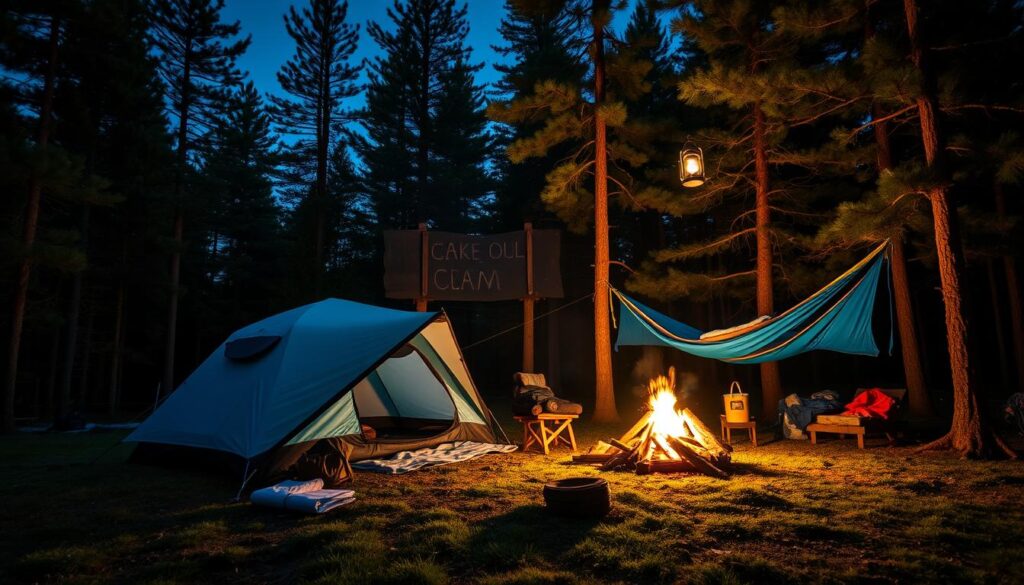
- Pre-pack meals in resealable bags for easy cooking.
- Invest in a reliable cooler to keep perishables fresh.
- Use a portable grill for versatile outdoor cooking.
- Always have a trash bag to dispose of waste properly.
- Locate your campsite away from water sources to protect the ecosystem.
By following these tips, I can enjoy nature more while helping the environment. Simple steps like planning and being responsible can make any camping trip better.
How to Choose Best Sleeping Bags for Camping in Any Season
Choosing the right sleeping bag can be tough, with so many options out there. It’s key to think about your camping needs, like the weather and how comfortable you want to be. All season sleeping bags are great because they work in different weather, from cold nights to warm evenings.
Start by looking at the insulation types. Synthetic insulation is light and keeps moisture out, good for damp places. Down insulation is warmer for its weight, best for cooler weather. Your choice affects your camping comfort.
Think about the sleeping bag’s weight too. If you’re backpacking, you’ll want a light bag. Car campers might prefer a bit heavier bag for more comfort. Choose a bag that fits your camping style.
| Feature | Synthetic Insulation | Down Insulation |
|---|---|---|
| Weight | Heavier | Lightweight |
| Warmth | Good | Excellent |
| Moisture Resistance | High | Low |
| Drying Time | Quick | Slow |
Waterproofing is also important. If you camp in wet places, choose bags with water-resistant shells. This keeps you warm and dry in bad weather.
Check the temperature rating on sleeping bags. All season bags have a range for different temperatures. This ensures you stay warm in winter and cool in summer.
In short, think about your camping needs, insulation, weight, waterproofing, and temperature ratings. With this info, picking the right sleeping bag for your adventure is easier.
Conclusion
Looking back, making your campsite better can really change your outdoor time. The five DIY projects we talked about each have their own benefits. You can make a portable campfire for warmth, a custom campsite sign, or a comfy camp bed for good sleep.
These projects are not just useful; they also let you be creative and make your campsite your own. Trying out these ideas can make your camping trips much better. I suggest trying different materials and designs to let your creativity shine.
There are endless ways to make your campsite better, and sharing your creations with others makes it even more fun. Camping is about making memories and connecting with nature and each other.
In short, these DIY projects show how important creativity, usefulness, and comfort are for a great camping trip. I hope these ideas inspire you to start your own DIY projects. This way, you can have many more fun outdoor experiences.

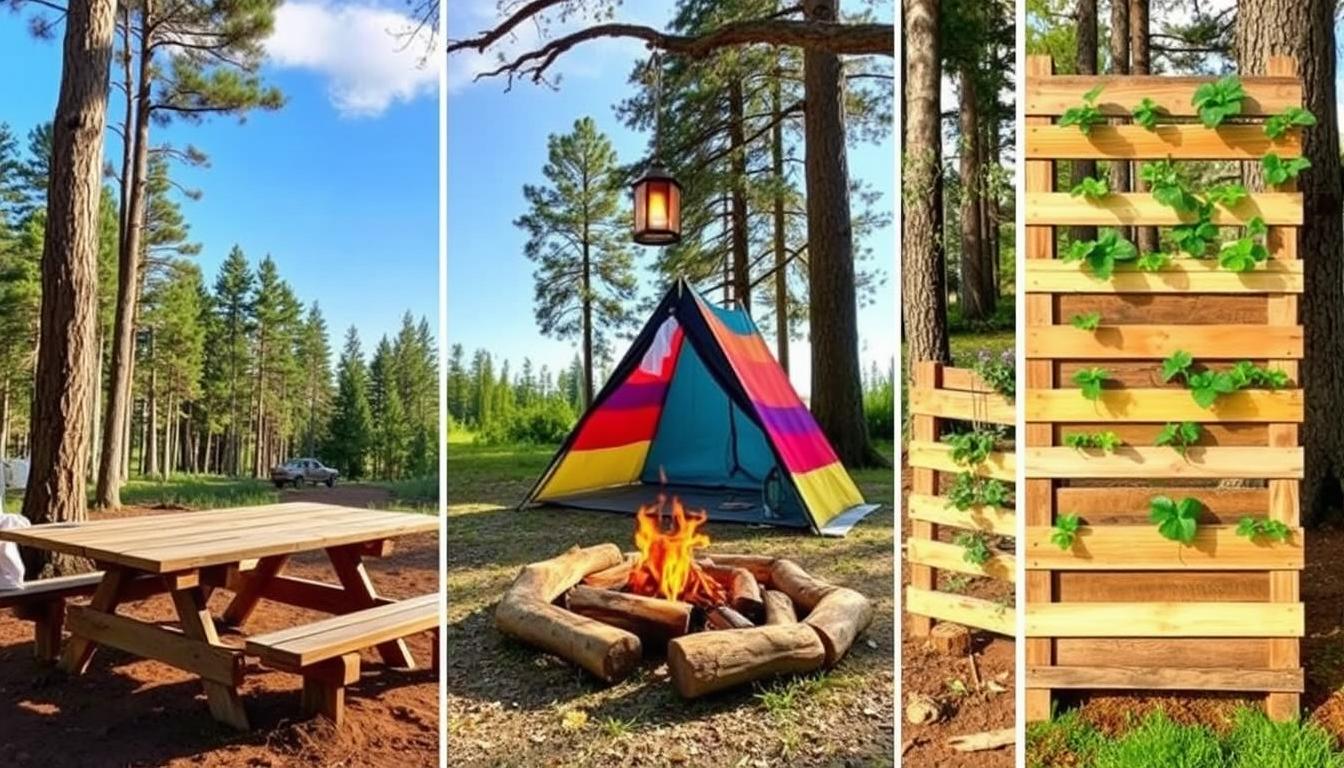

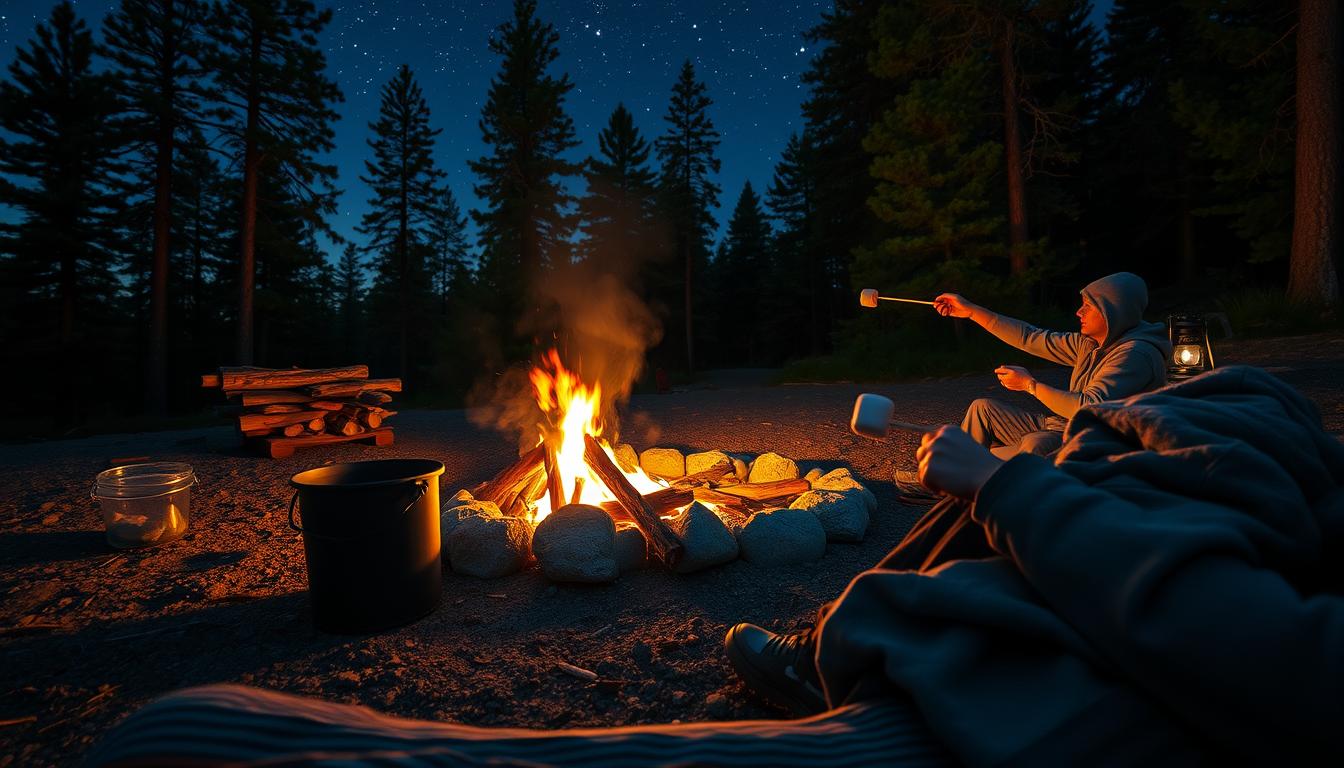
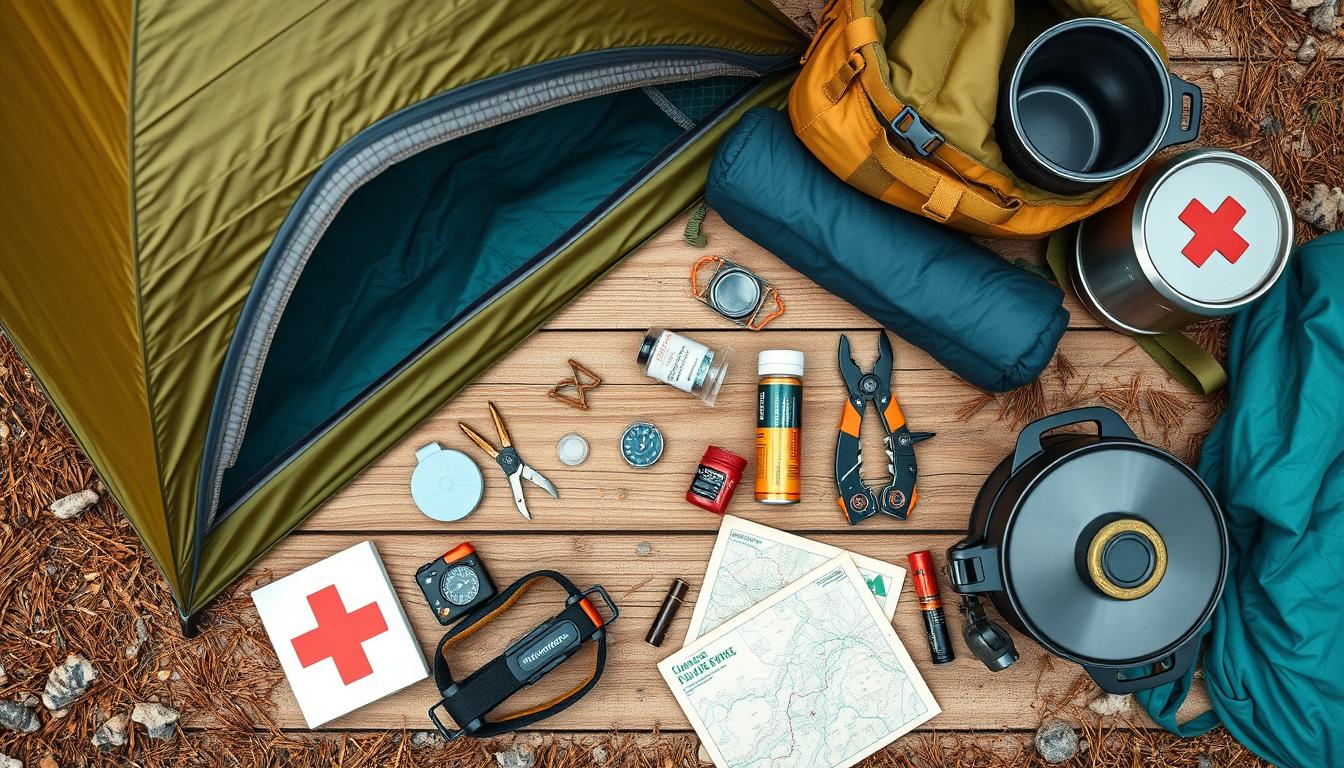
Leave a Reply